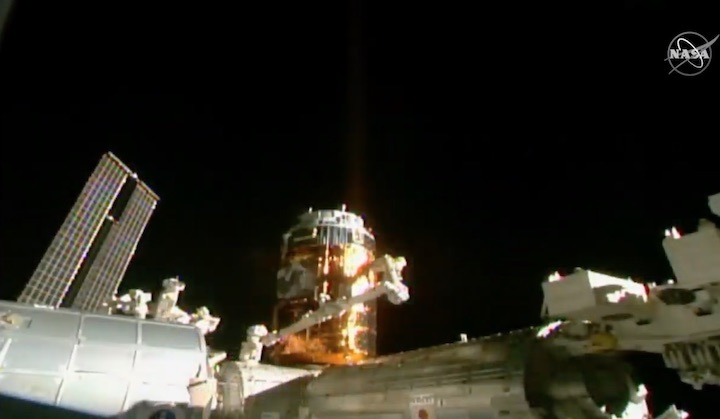26.05.2020

The last of Japan’s current series of HTV cargo freighters arrived at the International Space Station Monday with a fresh set of lithium-ion batteries, ready for installation on the research lab’s solar power truss after the scheduled docking of a two-man crew on a SpaceX Dragon spaceship later this week.
The automated supply ship was captured by the station’s Canadian-built robotic arm at 8:13 a.m. EDT (1213 GMT) Monday, while the vehicles soared some 260 miles (418 kilometers) over Tanzania.
NASA astronaut Chris Cassidy, commander of the space station’s Expedition 63 crew, controlled the robot arm for Monday’s capture of Japan’s ninth H-2 Transfer Vehicle. Ground teams then took over commanding of the robotic arm to berth the HTV to the space station’s Harmony module, where it’s due to remain until July.
The mission marks the final flight of Japan’s current HTV spacecraft design, which first reached the space station in 2009. The Japan Aerospace Exploration Agency is developing an upgraded cargo vehicle named the HTV-X, which is slated to fly to the space station for the first time in 2022.
Unlike the HTV, which is grappled by the robotic arm and berthed with the space station, Japan’s HTV-X is designed to directly dock with the orbiting outpost, using the same docking ports as SpaceX’s Crew Dragon and Boeing’s Starliner crew capsules.
“It was an honor for Expedition 63 to be part of the final HTV mission, a vehicle that has contributed so greatly to the International Space Station program. Congratulations to our friends and colleagues in Tsukuba,” Cassidy said Monday, referring to JAXA’s space station control center in Tsukuba, Japan.
During its autonomous rendezvous Monday, the HTV was expected to test a new wifi data link with the space station. The wifi link will allow video transmission between the future HTV-X vehicles and the space station during docking.
JAXA provides resupply services to the space station to help pay for Japan’s share of the the research lab’s operating costs. In addition to space station missions in low Earth orbit, Japanese officials say the HTV-X spacecraft could haul logistics to the future Gateway mini-space station near the moon.
The ninth HTV spacecraft lifted off Wednesday, May 20, from Tanegashima Space Center in southern Japan atop an H-2B rocket. The H-2B launcher is also being retired with the final HTV flight. The HTV-X missions will launch on Japan’s next-generation H3 rocket.
The HTV spacecraft is nicknamed Kounotori, which is Japanese for “white stork,” and stretches around 33 feet (10 meters) long and 14 feet (4.4 meters) wide. The ninth HTV mission, or Kounotori 9, is packed with more than 13,600 pounds, or 6.2 metric tons, of cargo, supplies and experiments in its pressurized module and on its external payload bay, according to JAXA.
The unpressurized cargo consists of the six new lithium-ion batteries stowed on a pallet inside the HTV’s external payload compartment.
The Japanese freighter also delivered hardware for government, university and commercial experiments.
One of the payloads packed inside the ninth HTV mission is a module to support a Japanese combustion experiment. The investigation will “scientifically determine the role of gravity in different modes of combustion, such as ignition of solid materials and spreading of flames on various solid materials in the ISS’s environment,” JAXA said on its website.
The HTV is also carrying a camera designed by a Spanish company named Satlantis, which aims to demonstrate the performance of the imaging unit on a platform outside the space station’s Kibo laboratory. Similar cameras could become a standard for future Earth-imaging CubeSats and microsatellites, according to Satlantis.
Japan’s space agency is also delivering new science racks for to the space station NASA and the European Space Agency, plus a water tank and fresh food for the research lab’s crew.
Assuming it launches May 27, the Crew Dragon is scheduled to dock with the space station May 28.
The arrivals of the HTV and Crew Dragon in quick succession will make for a busy few days on the space station, which is operating with a limited crew of three, and just one NASA astronaut responsible for the U.S. segment of the orbiting outpost.
Astronauts Doug Hurley and Bob Behnken will fly to the space station on the Demo-2 flight. Their stay at the station could last one-to-four months
Hurley and Behnken will assist Cassidy — the sole NASA crew member currently on the station — with experiments and spacewalks. Behnken and Cassidy are slated to perform several spacewalks as early as June to install the lithium-ion batteries to be delivered by the HTV mission.
Inside the station, Hurley will operate the research lab’s robotic arm to move Cassidy and Behnken around during the spacewalks. The batteries on the ninth HTV flight will be installed on the space station’s outboard S6 segment on the far starboard side of the craft’s 356-foot-long (108.5-meter) truss structure.
Once the battery spacewalks are complete, old nickel-hydrogen batteries replaced by the new lithium-ion units will be loaded into the HTV’s external cargo pallet and disposed during the cargo ship’s destructive re-entry at the end of its mission.
Quelle: SN

